INTRODUCTION
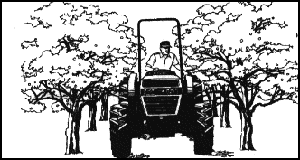 Modern
farm tractors provide most of the muscle power needed for today's
high output agricultural enterprises. Tractors are more common
on farms than any other piece of equipment and are used to carry
mounted and semi-mounted implements, to transport equipment
and materials, to pull tillage equipment and wagons and as remote
power sources for other equipment
Modern
farm tractors provide most of the muscle power needed for today's
high output agricultural enterprises. Tractors are more common
on farms than any other piece of equipment and are used to carry
mounted and semi-mounted implements, to transport equipment
and materials, to pull tillage equipment and wagons and as remote
power sources for other equipment
Unfortunately every year, tractor accidents result in serious disabling injuries and tragic loss of life. Losses due to property damage, medical bills, time off work, reduced productivity and insurance costs are considerable. The major causes of injury and death to tractor operators are rollovers, falls and contact with tractor attachments.
Statistics show that in Ontario 244 people died as a result of tractor-related accidents between 1980 and 1994. This accounted for almost 48% of the total fatalities for that period. Clearly one-half of all fatalities are caused by this agent of death. The vast majority (about half) of these fatalities were tractor rollovers to the side or the rear.
During a recent eight year period in Ontario, there were more than 450 hospitalizations for accidents involving farm tractors. The average length of stay in hospital was 10 days for these injuries with a maximum for one individual of 130 days for an accident involving a power takeoff shaft contact.
Manufacturers are continually improving the design of tractors to make them more safe. However, they are unable, as yet, to build in mechanisms which recognize unsafe conditions. Tractor operators who know their machine and are aware of the hazards which may occur, are better equipped to avoid a tractor mishap.
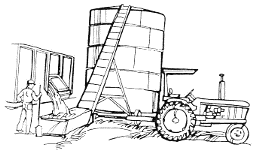
Falls from moving tractors often result in serious and sometimes fatal injuries. Many times the victim is a child, but operators and adult riders can also fall. Falls often occur from smaller and/or older tractors used around the farmstead, where extra riders and overhead hazards are more common than in fields.
Another cause of tractor-related death and serious injury is being caught by, or entangled in, rotating power takeoff (PTO) shafts. In most cases, the PTO shields were inadequate or had been removed.
Other tractor-connected injuries and damage involve:
Colliding with motor vehicles or roadside objects;
Slipping and falling while mounting and dismounting;
Running over bystanders;
Striking overhead hazards;
Being struck by flying objects, broken parts, or hydraulic fluid;
Being crushed by a poorly supported tractor during repair work;
Sustaining cuts, bruises, burns and other nuisance, but painful injuries, connected with maintenance and routine operation;
Being overcome by exhaust gases inside closed buildings;
Being burned by fires that erupt during refueling or as a result of a collision or upset.
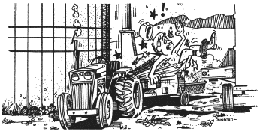
Each operator should be physically and mentally fit when operating a tractor. An operator who is sleepy, tired or not feeling well may not be able to react in time to avoid an accident. Your tractor does what you make it do.
Be Properly TrainedStudy the various decals on your equipment. They may point out DANGER, WARNING and CAUTION for various points on the tractor. Have an experienced tractor operator with you as you review the various decals and ask questions!
A copy of all operating manuals and other relevant safety materials should be kept on file for quick reference.
Use Tractor for Intended PurposesService Walkaround: Walk around the tractor a second time to check the tractor itself. This time look at the tires for wear and inflation, the power takeoff shaft for shielding and guarding (rotate the shield to make sure it moves freely), the hitch for proper hitch pin and safety clip. Pay particular attention to the ground under the tractor for any signs of liquid leaks such as oil, coolant or fuel.
Check the oil: Remove the dipstick, wipe it clean and check the oil level. If oil is required, remember to wipe off the filler cap before you remove it to avoid dirt falling into the engine. Use a clean funnel and clean the top of the oil can to prevent rust or other foreign objects going in with the oil.
Check the radiator: Slowly remove the red cap and check the liquid level.
Check the air pre-cleaner and air cleaner. Remove and shake out any dirt.
Check the fuel level. Fill if necessary, but it should have been filled at the end of the last day the tractor was used.
Check the fire extinguisher. Your tractor should have a fire extinguisher in case of fire during operation or refueling. Make sure it is charged and easily accessible.
Before servicing hydraulic systems:
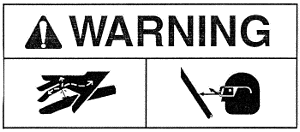
Yes
No
![]() Are you in good
health?
Are you in good
health?
![]() Are you free from
the effects of drugs and alcohol?
Are you free from
the effects of drugs and alcohol?
![]() Are you wearing
hearing protection?
Are you wearing
hearing protection?
![]() Are your close
snug-fitting?
Are your close
snug-fitting?
![]() Are you wearing
safety glasses?
Are you wearing
safety glasses?
![]() Is any long hair
tucked under a hat?
Is any long hair
tucked under a hat?
If you answered NO to any question, DO NOT OPERATE THE TRACTOR!
STARTING AND STOPPING YOUR TRACTORShutting down the engine:
Note: Everyone on the farm including family and employees should be taught how to safely shut off machinery. This is especially important in an accident situation. The first person on the scene must know how to shut things off. It could save a life!
Take Special Care With Large Four-Wheel Drive Tractors With Articulated Steering

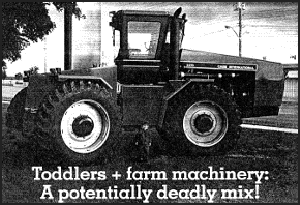
Make sure that everyone is clear from around the tractor before starting it in motion. There have been many fatalities in Ontario where small children were not seen and were run over. Sometimes you may wish to sound the horn to warn others that you are moving out. This also gives you the opportunity to test the horn before highway travel.
Case
History: Unaware of the two year old victim's presence, the
driver of a tractor backed up and ran over the victim.
When you engage the power to the drive wheels, do so slowly.
Test your brakes as you start out at a slow speed. Likewise turn your steering wheel in each direction to make sure it operates as it should. Power steering should be quick and responsive.
If the power steering ceases to operate, stop the tractor immediately.
If a load is attached, make sure that it is hitched to the drawbar. Pulling from any point above the rear axle could cause the tractor to flip over backwards. Make sure that you are using a drawbar pin that locks in place, and is of proper size for the job at hand. Often we have seen operators trying to "make do" with a bolt or pin too small and a bump or other situation could pop the pin and cause you to lose your load.
When heavy loads and equipment are attached to the rear of the tractor you may notice that the front of the tractor may start to rise. If this occurs, you should install front-end or wheel weights to help keep the tractor stable.
Watch where you are going while operating the tractor, particularly near ditches and embankments, on the roadway and near obstacles such as rocks and trees. Watch for overhead powerlines, especially if you a pulling implements or a load that may come near them. If a long grain auger or other high load contacts or even comes near some lines, an electrical charge may follow the easiest path to ground which could endanger your life.
Too often we hear of tractors and wagons jack-knifing. If any towed vehicle has a total weight that exceeds that of the towing tractor, then the vehicle should have independent brakes for safe operation.
Use Engine Braking
Case
History: A farm tractor was pulling a load of hay down a steep
grade. After traveling approximately 85 meters down the slope,
the driver prepared to turn right. The tractor veered sharply
to the right and overturned, pinning the operator.
Crossing slopes also can be dangerous. The operator should be alert for dips and raises that could trigger an overturn. If the tractor becomes unstable while operating on a slope, avoid an overturn and regain stability by turning down grade.
Some farms may have other 'obstacles' to contend with such as small bridges over creeks or paths over railway lines. Small bridges should be constructed in such a way that they are capable of handling the weight of your tractor and whatever implements and load you are towing. The bridge you construct should also have bullrails (boards along the edges) to prevent the tractor wheels going off the side. Make sure the bridge is wide enough and always try to approach it straight on when possible, lining up trailing equipment.
ROLLOVER PROTECTIVE STRUCTURESOne should never drill holes into or alter the rollover frame in any way. Some people have been known to drill holes to mount radios etc. This practice is dangerous. The ROPS structure becomes weaker at that point and in the event of a rollover, it could cave-in or collapse, not offering total protection to the operator.
ROPS can be either a protective frame that is highly visible or built into a cab structure. Rollover protective structures are available for many older tractors as well. Check with your dealer or manufacturer to determine if one exists for your tractor. In recent years, many manufacturers have reduced the cost of ROPS or subsidized the installation of them.
TRACTOR STABILITYThese include:
Centrifugal force is a force that tends to resist a change in direction. If a tractor was traveling in a straight line then suddenly turned, there would be a tendency for the tractor to want to continue in that straight line. This is centrifugal force. By doubling the tractor's speed, the centrifugal force is increased four times.
Raising a load such as with a front end loader, also raises the centre of gravity, making the tractor less stable, or a little top heavy.
Heavy implements or loads mounted on the rear of the tractor will shift the centre of gravity further to the rear making it easier to flip backwards.
Crossing steep slopes can change the centre of gravity depending upon the angle of the slope.
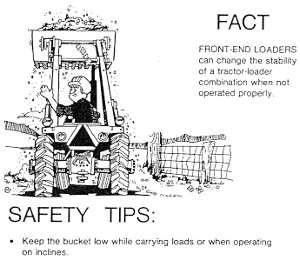
Keep the loader bucket low while transporting loads. As mentioned above, a raised bucket can change the centre of gravity of the tractor. Obstacles on the traveling surface such as rocks,boards,or holes in the ground could lead to a quick upset if the load is carried too high. Avoid traveling downhill with loaded buckets.
Restrict your speed when traveling with a load. Remember, keep it low, travel slow. The added load which you carry in the bucket adds to the momentum of the tractor. If you were moving at a high speed and decided to turn it could flip you over.
Keep your load even in the bucket. An uneven load could lead to dangerous situations. Your loader can only hand so much weight and you don't want to put undue stress on the various components. Check your operator's manual for the loader's capacity.
Ballast will help give you stability. Extra ballast will help counter-balance the extra weight at the front of your tractor and reduce rollover potential.
When not in use, remove your loader from the tractor. Having the loader always attached while trying to perform other duties with the tractor can make some situations complicated and lead to poor visibility and added fuel costs.
Don't misuse your loader. The loader bucket was not meant to be used as a work platform for people. Hydraulics can fail leading to tragedy.
When leaving your tractor-loader alone, lower the bucket to the ground. This is so that it cannot accidentally be lowered by children or others.
Handling large round bales: A number of operators have been injured when improperly secured bales rolled down the arms of the front-end tractor loaders. Proper restraining devices should be used to prevent the bales from coming loose. A manufactured bale spear, specifically for this purpose is ideal.
Loader Safety Tips.Never work or walk under a raised loader.
.Watch for overhead electrical wires and other obstacles when raising loaders.
.Be careful near banks and slopes. Added weight can cause them to collapse.
.Don't move or swing loads when people are working in the area.
.Never allow anyone to pass under a raised bucket.
.Keep the work area as flat as possible.
.Match
the proper bucket to the job you are doing.
Case
History: The victim was driving a loader tractor along the
shoulder of a road with the bucket raised. The tractor ran
off the shoulder and rolled over into the ditch. The victim
was pinned underneath the tractor.
HOW TO AVOID TRACTOR OVERTURNS
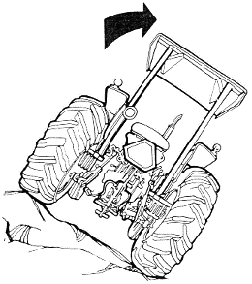
Driving across a steep slope: The greater the angle of the slop, the greater the danger will be of rollover. Your tractor was designed to distribute it's weight around the centre of gravity of the vehicle. If you cross a slope with a very steep angle there may be more weight on the downward side of the centre of gravity and the tractor could simply flip over. This problem is compounded by the fact that you may encounter obstacles which will change your stability such as potholes on the downhill side or rocks and other obstacles on the uphill side. Your tractor may also have side-mounted implements on it. You should keep the side-mounted implements on the uphill side of the slope for added stability. Don't raise the implements or loader buckets. Keep them as low to the ground as possible. Avoid turning uphill. If stability becomes uncertain, turn downhill. This could prevent a rear rollover.
Driving
too close to a ditch, culvert or pond can lead to the
tractor rolling into the ditch if you get too close to the
edge. A good rule of thumb is to stay as far away from the
embankment as the ditch is deep. This keeps you behind the
sheer line. The edge of a bank has little to hold it there
and the weight of your tractor can cause the earth to sheer
away along this line, causing you to slide into the ditch.
Case
History: The victim was cutting hay near the edge of an embankment.
The tractor went over the edge and rolled on top of the victim,
trapping the individual face down in approximately one foot
of water.
Turning while traveling too fast can result in a side rollover. As your vehicle travels faster it wants to continue on in the straight line in which you are heading. Without slowing down, if you make a sudden, quick turn, the weight of the tractor wants to keep going and causes it to flip over.
Driving with a front-end loader too high changes the centre of gravity of your tractor. It raises the centre of gravity, making it 'top heavy'. A sudden turn or raising the tractor on one side can cause a side rollover. The problem is compounded when the loader has material in it, especially if it is not evenly distributed.
Towing
a load that is too heavy to control can cause jack-knifing.
Case
History: The victim was driving a tractor and bale wagon down
a 40 degree slope. The wagon jackknifed, causing the tractor
to roll over and pin the driver.
Driving on roadways without locking rear brakes. If you do not lock your brake pedals together for travel on the roadway, should you need to apply them suddenly, you may only hit one pedal. If this occurs it could cause one wheel to lock up, leaving the other in motion. The result could cause you to swerve into the ditch or into oncoming traffic.
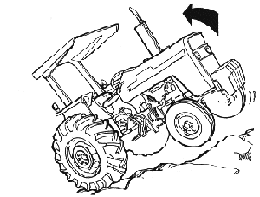
Case
History: The victim was using a tractor to pull out small
trees on a relative's farm. A chain was wrapped around the
base of the tree, and the other end was hitched to the rear
of the tractor. The hitch point was higher than the tractor's
rear axle. When an attempt was made to pull out the tree,
the tractor flipped over backward and crushed the victim.
Driving forward when stuck in mud or ice can be dangerous. If the tires are frozen to the ground or will not move, you could end up with a rear rollover when power is applied. If you get mired in mud, try backing your tractor out first. This will keep the front end down and reduce the risk of rollover. If the tractor does not become free, then you may need to tow it out. Make sure that the towing vehicle is heavy enough for the job and that the tow lines are hitched to the drawbar. The towing tractor must have a rollover protective structure on it.
The danger of rear rollover is especially significant when the tractor is towing of pulling a load with a chain or tow rope. As well as the possibility of a rollover occurring, there is danger in using tow ropes or cables. These items store energy by stretching under load. By jerking the rope or cable or making a running start to move a heavy stationary load can stress a nylon rope or cable to the breaking point. If it snaps, it will act like a stretched rubber band and sling back at the tractor. It could smash a cab's windows or even decapitate and operator.
How can this type of fatality be prevented?
Not all cabs presently being sold for tractors are crush proof; check and make sure that a cab is crush proof (R.O.P.S.) and meets A.S.A.E. standards.
Most major tractor companies have a low cost retro-fit roll-bar. The price for a roll-bar is insignificant when measured in terms of saving lives, or the pain and suffering resulting from serious injury.
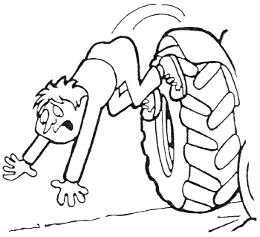
Never operate the tractor while riding on the draw bar, sitting on the fender, standing on the steps, or sitting on the backrest of the operator's seat. Do not attempt to get on or off of the tractor while it is in motion. Although a tractor may appear to be moving slow enough to jump on or off, a slip can leave you crushed under the wheels before the operator can react.
2.
Maintain safe operating speeds. Never drive so fast
that the front wheels of the tractor bounce. Watch ahead
for obstructions and avoid them. Slow down before making
turns. Always watch where you are going, particularly when
there may be obstacles such as tree limbs, ditches etc.
Speed and obstacles don't mix well.
3.
Rest when you are tired. Stop the tractor and lie
down for a short nap if you feel tired or sleepy. Stop for
10 or 15 minutes every 2 to 2-1/2 hours. Don't drive when
you feel like dozing. In this condition you are not alert
enough to operate a tractor. Fatigue has been blamed for
many tractor related fatalities in Ontario. Statistics show
that many of the fatalities and injury accidents occur after
the operator has been working with the machine for several
hours without breaks. A person is not as alert after a long
day compared to starting fresh in the morning.
You will often be tempted to use your tractor to transport a helper. Children often plead for rides. Do not give in. An unexpected bump or turn could toss an extra rider right out the cab door and off the tractor. Your passenger cannot anticipate every tractor movement and brace against it. Furthermore, all the vibration and bumps are transmitted to the passenger. He can easily lose his grip and fall off.
Passengers can cause other problems, too. They can interfere with your operation of controls, they can accidentally move controls themselves, and they frequently distract the operator's attention.
Many people think an extra rider is safe in the cab of a tractor, but in an accident the extra rider may be tossed around, hit the door, and be thrown out.
Make exceptions to the 'no extra rider' rule only under these conditions: when a second seat is provided on the tractor or instructions are being given or received. There is potential danger for the instructor while training a new operator, but the training is essential. The danger can be minimized by driving at a slow speed and on level ground.
MAKE 'NO RIDERS' THE RULE - NOT THE EXCEPTION
Case
History: The victim was riding on the fender of a tractor
driven by their spouse. An attached rotary mower was cutting
grass. As the tractor came close to a pine tree, branches
knocked the victim off the tractor and into the path of the
mower. The tractor could not be stopped in time, and the mower
ran over the victim.

One of the main reasons for tractor accidents is the difference in speeds between cars and tractors. The closure time - that is the time it takes for one vehicle to overtake another - is much less for farm machinery than with automobiles.
The short closure time means the driver of a passenger vehicle has but a few seconds to identify the tractor and react accordingly. This is why positive identification of slow-moving vehicles is important. The accompanying diagram illustrates this situation.
HOW FAST CAN YOU REACT?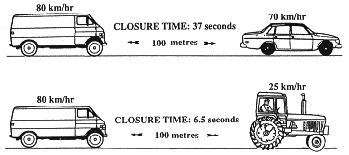
Before taking your tractor on the highway, you should ensure that it is prepared for such a trip and that your combination of vehicles conforms to the highway regulations where you will be operating.
Under the ONTARIO HIGHWAY TRAFFIC ACT, your farm tractor is not a motor vehicle but it is considered a vehicle. Registration plates are not required for farm tractors, farm implements or self-propelled implements of husbandry when traveling from farm to farm for farming purposes, or places necessary for repair or maintenance. Insurance coverage for the above mentioned vehicles is usually included in the farm insurance policy.
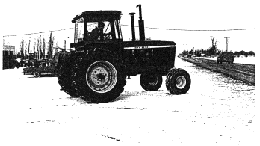
Safe farm equipment road travel requires knowledge of traffic rules, maturity and common sense.
The SLOW MOVING VEHICLE (SMV) SIGN is used to warn other road users that the vehicle displaying the sign may be a vehicle traveling slower than the normal speed of traffic. Every farm tractor or self-propelled implement of husbandry, when operating on a highway, or any vehicle towed by either of them must have a slow moving vehicle sign attached to the rear, except when directly crossing a highway.
Always be seen! Remember that the SMV sign is for your safety.
![]() It must be clearly visible for a distance of not less than
150 meters
It must be clearly visible for a distance of not less than
150 meters
![]() The SMV colours deteriorate through exposure to the sun
and weather. To ensure that the sign is clearly visible
to other road users, it should be replaced when faded or
damaged.
The SMV colours deteriorate through exposure to the sun
and weather. To ensure that the sign is clearly visible
to other road users, it should be replaced when faded or
damaged.
![]() As a driver of a vehicle, it is your responsibility, by
law, to clearly indicate all turns, slowing or stopping
and to make certain that a turn can be made safely.
If your equipment of load which you are towing does not
allow other drivers to see your hand signals, then you should
equip your vehicle with electrical or mechanical signals.
As a driver of a vehicle, it is your responsibility, by
law, to clearly indicate all turns, slowing or stopping
and to make certain that a turn can be made safely.
If your equipment of load which you are towing does not
allow other drivers to see your hand signals, then you should
equip your vehicle with electrical or mechanical signals.
* Your visibility is vital at all times. Always use your lights when it is dark or visibility is poor. Many collisions occur due to the fact that other motorists do not see you in advance.
A farm
tractor or self-propelled implement of husbandry if fitted
with an electric lighting system must display two white
lights on the front of the vehicle and at least one red
light on the rear of the vehicle. The lights must clearly
be visible at a distance of 150 meters If the vehicle is
not equipped with electric lighting, a lamp or lamps should
be placed on the left side of the vehicle with at least one
white light to the front and one red light to the rear.
Case
History: The victim was taking an orchard sprayer along a
road. The tractor was illuminated with headlights plus a rear-mounted
halogen working lamp. However, the sprayer wasn't fitted with
either a lighting system or a slow moving vehicle sign. As
a car approached from the rear, its driver assumed that the
halogen working light was an oncoming vehicle. The driver
moved the car towards the should of the road because the light
appeared to be crowding the centre line. The car struck the
back of the sprayer, causing the tractor to roll over onto
its roof. The victim was ejected from the tractor.
TOWING
EQUIPMENT ON ROADWAYS WITH YOUR TRACTOR The highway
Traffic Act does not limit the number of wagons or trailers
that may be towed by a farm tractor or self-propelled implement
of husbandry. The driver is responsible to ensure that the combination
does not constitute a hazard. Each farm wagon or other implement
of husbandry being towed must be connected to the towing vehicle
by two separate means of attachment. Also, each trailer or
farm wagon must have two separate means of attachment to the
vehicle ahead. A safety chain's strength must be equal to
the gross weight of the vehicle or vehicles being towed. This
does not apply when towing a farm wagon or implement of husbandry
directly across a highway.
DRIVER LICENCES
The
driver of a farm tractor or self-propelled implement of husbandry
is not required to hold a valid driver's license when
driving on a highway, but must be at least 16 years of
age. Under 16 year -olds are only allowed to drive a
self-propelled implement of husbandry directly across a highway.
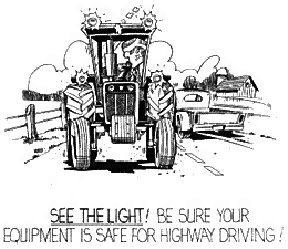
The PTO spins at speeds fast enough to wrap a person up in it before they know what happened. All it takes is a thread, shoestring, raveled jeans, or even long hair to get a person wrapped up in this powerful piece of machinery. A 540 rpm PTO shaft will rotate nine times in one second and travel 2.17 meters This means that if a bootlace catches on the PTO shaft that in one second almost 2.17 meters of lace will be wrapped up before you can even react! A 1000 rpm PTO shaft will rotate 16.7 times and travel four meters in one second!
Never remove shields from a PTO shaft. Even PTO shafts with guards are dangerous to step over. To be safe, walk around your equipment. The extra few seconds taken will help to insure you of more years of life.

An unguarded PTO shaft is dangerous. It can catch on your clothing before you realize it. If you're lucky, your clothes will tear, freeing you without serious injury. If you're not so lucky, you could be strangled or mutilated by the high-speed shaft.
Master shields help to prevent accidental contact with the tractor stub shaft and the front universal joint of the attached machine's driveline.
PTO shaft guards are provided for many tractors to completely enclose the tractor stub shaft when the PTO is not being used.
A PTO rolling shield completely encloses the PTO shaft. These shields are metal or plastic tubes supported on bearings so the shields rotate independently of the shaft. When the PTO shaft is turning, they rotate with it. But if a person contacts the shield, the rotating shield stops while the shaft inside continues to spin.
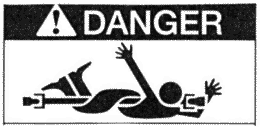
To prevent injury from entanglement with the power take-off shaft, follow these safety rules:
The measurement of sound or noise is related to pressure, frequency and duration, and is commonly measured in units called decibels.
With continual exposure to excessive noise, the ability to hear normal conversation is impaired.
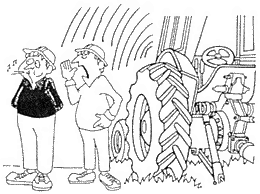
Noise is too loud when:
If you do not have a cab that reduces noise significantly you may need to wear hearing protection in the form of ear plugs or muffs designed to block out harmful noise levels.
SAFETY IN TRACTOR OPERATIONSafety practices begin with YOU. To be safe..... you need to think safe. Farming is one of the most hazardous occupations. Accident prevention requires a constant, conscious effort by those involved in farming. Here is a list of some things you can do to help prevent accidents:
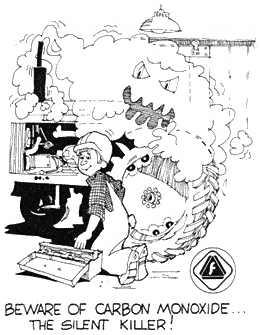
____1. Refueling an engine presents no danger of fire if it is shut off.
____2. To inspect for leaks in hydraulic lines, run your hands over the hoses.
____3. Hand holds are placed on tractors for extra riders.
____4. Always shut off the engine and apply the parking brake before dismounting the tractor.
____5. All PTO shafts should be guarded with the proper shielding.
____6. Tractors may be started safely only from the operator's seat.
____7. Noise levels of 100 decibels on a tractor are considered safe for an 8 hour exposure.
____8. When traveling, the front-end loader should be positioned high for good visibility.
____9. Weights help keep the front end of the tractor down.
____10. Proper training is essential for safe tractor operation.
____11. Tractor upsets are a leading cause of tractor fatalities.
____12. It is alright to drill holes in a ROPS frame to mount a CB radio.
____13. Hitch pins should always have proper safety catches to prevent accidental unhitching.
____14. When towing a load, go down the hill in the same gear as you would go up a hill.
____15. It is not necessary to use a seat belt when the ROPS is built into the cab.
____16. When driving your tractor on the roadway, you must have a slow-moving vehicle sign on the rear of the tractor.
____17. A tractor operator must be sixteen years of age to drive on the highway in Ontario.
____18. Be sure the highway is clear of traffic before pulling into it.
____19. When towing equipment on the highway, you must have a proper safety chain hook-up.
____20. When pulling a load up a slope, keep the hitch as high as possible.
____21. When stuck in the mud try to back out first.
____22. The position of a tractor's loader changes the centre of gravity as the position of the loader changes.
____23. Three is the maximum number of riders allowed on a tractor.
____24. If you are working with a tractor with rollover protection, always wear your seatbelt.
____25. Always read the operator's manual before operating a new tractor.
____26. A tractor can flip completely backwards in about 1.5 seconds.
____27. Do not make sharp turns at high speeds.
____28. If tractor stability becomes uncertain on a slope, turn downhill.
____29. In Ontario, you are required to signal your intention to turn when operating a tractor on a roadway.
____30. Check your tires and wheels for proper pressure and tread regularly.
ANSWERS TO QUIZ:Here are the correct answers to the questions marked false:
TRACTOR AND WAGON EXERCISE - Total Points: 400/300 for skill and safety plus 100 for time
(Time Limit: 20 minutes)
The following is a brief description of how the competition works:
The judge for this exercise will start recording the time by means of a stop watch, once he/she has handed the keys for the tractor to the contestant.
The contestant will then mount the tractor (in parking station). He/she must always remember to use the three point method whenever he/she mounts or dismounts from the tractor. He/she must never jump on or off the tractor.
The judge will look for any loose clothing on the contestant, such as open shirts, coats, untied shoe laces, etc. Once the contestant has mounted the tractor, he/she is to put his/her seat belt on. He/she will then start the tractor, having first checked to see if it is in the "park" position, and that the clutch has been disengaged.
Once the tractor is in motion, he/she will depress the brake pedal to check to see if the tractor has brakes. He/she will then proceed to the wagon station. The contestant must back the tractor up to the wagon, so that the draw bar is in the exact position for the contestant to swing the wagon tongue into position and freely drop the draw pin in. He/she will not be allowed to manually move the tractor or wagon to assist with the hook-up.
The contestant will hook-up the safety chains on the wagon on to the tractor, remove the slow moving vehicle sign from the tractor and place it on the rear of the wagon. He/she will then remove the wheel blocks from the right hand rear wheel of the wagon, and place them on the wagon.
The contestant will then mount the tractor and proceed to enter the course as specified ion the diagram layout. He/she must travel at a safe speed to allow him/her to maneuver between the five gates on the right hand side of the course. A predetermined amount of points will be deducted for each ball knocked off, and each stake knocked over. He/she will be allowed 40 feet at the end of the course to make his/her turn, to allow entry through the five gates on the left hand side, which are the same as those for the right hand side. On passing through the last gate on the left hand side, the contestant will drive the tractor into the wagon park station area, and directly through the two guide stakes, which allow for three feet of clearance on each side of the wagon. The front wheels of the tractor must be ahead of the front two guide stakes before he/she commences to back the wagon up to the wagon park position area.
For each consecutive attempt to back the tractor and wagon up to the parking station, points will be deducted. Because the back of the wagon will be covered with an 8' x 4' sheet of plywood, it may be necessary for the contestant to stop the tractor and get off to check to see just how close he/she is to the stakes at the rear of the wagon. He/she must also be careful not to cramp the wheels of the wagon, or points will be deducted.
The wagon must be in the centre of the parking station, and within 6" of the stakes at the rear of the wagon. For each inch that the wagon is off centre, and for each inch that the wagon is further away than 6" from the rear stakes, points will be deducted. The contestant must be very careful not to knock the ball off of the rear of the wagon, because he/she will lose in excess of 100 points if he/she does.
Once the wagon has been parked, the contestant will then take the blocks off the wagon and put them behind and in front of the rear wheel of the wagon. He/she will then proceed to unhook the wagon (safety chains and draw pin). The draw pin is to be left in the tractor draw bar.
The contestant will then take the slow moving vehicle sign from the rear of the wagon and attach it to the tractor. He/she will then return the tractor to the parking station, by backing it up to the stake. He/she must remember to put the tractor in "park", and to take the keys out of the tractor and hand them to the judge. The stop watch will then be stopped, and the time recorded.
PERSONAL PROTECTIVE EQUIPMENT1 - Wagon
running gear complete with bolster.
Flat bed is 16 to 18 feet long and 8 feet wide.
Rear of the flat bed is to be covered with a 4 x 8 sheet of
plywood.
The running gear is to be extended to 120 inches from the centre of the front axle to the centre of the rear axle.
The wagon bed is to be placed on the running gear so that the measurement from the front of the wagon to the front axle is approximately 33".
Space requirements for this exercise, approximately 210' x 80'.
Surface requirements - ideally, the competitions should be run on a paved surface.
TIME FACTOR FOR TRACTOR AND WAGON EXERCISE10 minutes or less is a perfect score = 100 points
10 minutes, 1 second to 11 minutes = 80 points
11 minutes, 1 second to 12 minutes = 60 points
12 minutes, 1 second to 13 minutes = 50 points
13 minutes, 1 second to 14 minutes = 40 points
14 minutes, 1 second to 15 minutes = 30 points
15 minutes. 1 second to 16 minutes = 20 points
16 minutes, 1 second to 17 minutes = 10 points
17 minutes, 1 second to 20 minutes = 0 points
Failure to complete the above-mentioned exercise in a time limit of 20 minutes will mean the automatic disqualification of the contestant.
The time starts as soon as the contestant takes the keys from the clockman. The time ends as soon as the contestant hands the keys to the clockman, or walks away from the tractor without the keys.
TRACTOR AND WAGON EXERCISE (SAFETY FACTORS) SAFETY
| Description of Penalty & Number of Points Lost | . | Indicate penalties with X | Total Demerit points |
| 1. For each item of P.P.E. missing deduct. | 20 | . | 20 x = |
| 2. For loose clothing on contestant. Each offense deduct. | 20 | . | 20 x = |
| 3. Failure to use the 3 point method when mounting or dismounting (no jumping). each time deduct. | 10 | . | 10 x = |
| 4.
Failing to put the tractor "in park" before starting or
on dismounting from tractor. each time deduct (If he has difficulty is getting the tractor in park, he must try for at least 10 seconds to get into park). |
10 | . | 10 x = |
| 5. Failure to use and adjust seat belt before putting the tractor in motion. each time deduct. | 20 | . | 20 x = |
| 6. Failure to disengage the clutch before starting. each time deduct. | 20 | . | 20 x = |
| 7. Failure to lock brakes together before putting the tractor in motion. each time deduct. | 20 | . | 20 x = |
| 8. Failure to check the brakes for in the first 5' of travel. deduct. | 20 | . | 20 x = |
| 9. For excessive riding of clutch. deduct. | 10 | . | 10 x = |
| 10. Failure to operate the tractor at a safe speed deduct. | 20 | . | 20 x = |
| 11. Failure to properly fasten the safety chains deduct. | 20 | . | 20 x = |
| 12. Failure to properly fasten the SMV sign on rear of wagon deduct. | 20 | . | 20 x = |
| 13. failure to remove wheel block from wagon and place on wagon deduct. | 20 | . | 20 x = |
| 14. For cramping of wagon wheels, i.e. wheels skid or tractor wheels hit wagon frame. each time deduct. | 20 | . | 20 x = |
| 15. Failure to properly block wagon wheels before unhooking wagon deduct. | 20 | . | 20 x = |
| 16. Failure to remove keys from the tractor upon completion, before dismounting deduct. | 20 | . | 20 x = |
TRACTOR AND WAGON EXERCISES (SKILL FACTOR) SLILL
| Description
of Penalty and Number of Points lost |
. | Indicate each penalty with an (X) | Total Demerit Points | ||||
| 1. For each consecutive trial of moving the tractor for hook up to wagon deduct | 5 |
. | 5 x = |
||||
| 2. For manually moving wagon or tractor to assist with hook up deduct | 50 |
. | 50 x = |
||||
| 3.
For each stake that is hit in the course in such a manner
that it produces the following results: deduct as follows:
Each ball knocked off deduct Each time the top of the stake is moved approx. 6" or more deduct For each stake knocked over deduct |
5 15
|
. | 5 x = 15
x = |
||||
| 4. For each consecutive trial of moving tractor and wagon ahead to line up in parking station deduct | 5 |
. | 5 x = |
||||
| 5.
For touching ant stake in wagon park deduct For knocking off a ball in the wagon parking station deduct For each stake is moved backwards approx. 6" or more deduct For each stake that is knocked over in the parking station deduct |
20
50 50 50 |
. | 20
x =
50 x = 50 x = 50 x = |
||||
| 6.
If distance away from the loading dock is greater then
6". measure from furthermost point. For each inch more then 6" deduct |
5 |
. |
5 x = |
||||
| 7.
For each inch off center of loading dock. For each inch deduct |
5 |
. | 5 x = |
||||
| 8.
When the draw bar is further away then 1 inch from the
stake in the Tractor Park Station. For each inch deduct When the draw bar is completely off center in the Park Station deduct |
10 20 |
. | 10
x = 20 x = |
||||
| 9.
For touching the stake in the Tractor Park station deduct
For knocking off a ball in the Tractor Park Station deduct For moving the stake in the Tractor Park Station more then 1 foot at the top deduct For knocking the Tractor Park stake over deduct |
10 20 30
|
. | 10 x = 20 x = 30
x = |
||||
| TOTAL DEMERIT POINTS ON SKILL________________ | |||||||
|
150 |
on Safety ____________ |
on Skill ______________ |
________________ |
||||
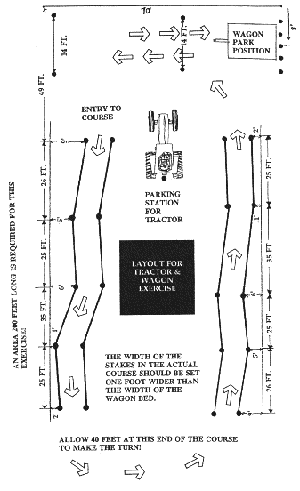
21 minutes - colour - 1974 Available on VHS
This video emphasizes the need for roll-over protection on tractors and also illustrates many safe operating procedures for tractors.
Produced by Massey-Ferguson, Great Britain.
VT 043 "Farm Tractor Safety"
11 minutes - colour - 1976 Available on VHS
Devoted to the positive aspects of tractor safety, this video shows tractor overturn tests followed operator precautions to avoid side and rear overturns. Importance of ROPS is emphasized along with PTO safety, extra rider hazards, fuel handling safety, and safe highway transport.
Produced by International Harvester, U.S.A.
VT 093 "Horsepower"
9:45 minutes - 1989 Available in VHS only
This video looks at tractor safety and features farmers who have experienced accidents while operating their tractors.
Produced by the Nova Scotia Farm and Home Safety Committee

VT 115 "It Won't Happen To Me (Tractor Safety)"
Time: 16 minutes
The basics of tractor safety are covered using Farm Safety Association's fatalities as examples of what can go wrong and lead to fatal situations. Emergency medical personnel are also interviewed about tractor accidents.

Produced by New Holland, 1995
VT 126 "Nellie the Farm Safety Dog"
Time: Approximately 7 minutes
This true story is about a tractor rollover accident which occurred on a Southern Ontario tobacco farm. Nellie, the resident dog on the farm brought help to save the farmer's life. The rescue is recounted by those involved including police and ambulance drivers.
Produced by the Ontario Ministry of Agriculture, Food and Rural Affairs
S 028 "Safe Use of Farm Tractors"
65 slides - audio tape and transcript - 1982
Tractors by far are the most common type of machinery used on a farm. Tractor related accidents also cause the majority of farm-related fatalities. This slide set discusses the safe operation of farm tractors, with particular emphasis on tractor roll-overs.
Produced by Agricultural Extension Service, University of Minnesota.
VT 044 "Target You - Tractor Safety"
10 minutes - colour - 1979 Available in VHS
This video is largely animated and by means of the principal character "Gotta-Go Joe", demonstrates many of the common accidents that a farmer can become involved in with his tractor, by trying to beat the clock.

Produced by John Deere Ltd.
VT 123 "Tractor Rollovers and ROPS"
Time: 6 minutes 30 seconds Available in VHS only
This video outlines the importance of having your tractor protected with a Rollover Protective Structure and covers ways that John Deere has made it easier to add this protection to your tractor.
Produced by John Deere
VT 051 "Tractor Safety"
21 minutes - colour 1977 Available in VHS only
This video covers all the basics of safe tractor operation. Produced by Perdue University.
VT 129 "Tractor Safety on the Farm"
Time: 11 minutes 30 seconds

This video covers the basics of tractor safety including the pre-operational check, starting and stopping; operation of the tractor including rollover situations; power takeoff safety and travel on public roadways.
Produced by the Farm Safety Association Inc, 1994
VT 092 "Tractor Tips"
17 minutes - colour 1990 Available in VHS only
Shows tractor operation and management techniques that reduce fuel consumption in field operations. Discusses safe ballasting, gearing up-throttle down and equipment matching.
Produced by Independent Study, University of Guelph
VT 045 "Tractor Safety Begins With You"
20 minutes Available in VHS only
This video depicts a number of situations which led to tractor accidents happening involving extra riders, the P.T.O. and rollovers.
Produced by Kubota.
VT 101 "Tractor Safety Is No Accident"
15 minutes - colour - 1982 Available on VHS
A professional airline pilot who is also a farmer narrates this video on tractor safety. The narrator applies the same reasoning in operating tractors as he does with airplanes. A number of important areas are covered such as: the walk around check; tractor rollovers; transporting equipment; P.T.O. safety; extra riders; maintenance and service.
Produced by International Harvester, Chicago, Illinois, U.S.A.
VT 046 "Why Did Tommy Die?"
10 minutes - colour - 1980 Available on VHS
A number of young people are killed each year by tractors. Through the video's characters, John, Merriam and Tommy, the video explores the principle causes of tractor injuries and fatalities. The video demonstrates tractor fires, P.T.O. accidents, and tractor rollovers.
Produced by the Ontario Ministry of Agriculture and Food.
VT 047 "Within The Frame of Safety"
6 minutes - colour - 1969 Available on VHS
This video details the designing, testing and development of a protective frame for tractors. These structures when used in conjunction with seat belts, help prevent injuries due to side-rolls or back-flips.
Produced
by International Harvester, U.S.A.
| Farm Tractor Safety | yes | no |
|
Corrected |
|
 |
 |
. | . |
|
 |
 |
. | . |
|
 |
 |
. | . |
|
 |
 |
. | . |
|
 |
 |
. | . |
|
 |
 |
. | . |
|
 |
 |
. | . |
|
 |
 |
. | . |
|
 |
 |
. | . |
|
 |
 |
. | . |
|
 |
 |
. | . |
|
 |
 |
. | . |
|
 |
 |
. | . |
|
 |
 |
. | . |
|
 |
 |
. | . |
|
 |
 |
. | . |
|
 |
 |
. | . |
|
 |
 |
. | . |
|
 |
 |
. | . |
|
 |
 |
. | . |
|
 |
 |
. | . |
|
 |
 |
. | . |
|
 |
 |
. | . |
|
 |
 |
. | . |
PTO Driven Equipment
|
 |
 |
. | . |
|
 |
 |
. | . |
|
 |
 |
. | . |
|
 |
 |
. | . |
|
 |
 |
. | . |
|
 |
 |
. | . |
|
 |
 |
. | . |

Farm
Safety Association Inc.
22-340 Woodlawn Road West,
Guelph,
Ontario N1H 7K6
(519) 823-5600
Fax: (519) 823-8880
Ontario
Ministry of Agriculture,Food and Rural Affairs
Farm Safety Association Home Page
Added to the database: 1999
Disclaimer and Reproduction Information: Information in NASD does not represent NIOSH policy. Information included in NASD appears by permission of the author and/or copyright holder. More